优质课教案仁爱英语八年级上unit3topic1sectionA
- 格式:doc
- 大小:17.50 KB
- 文档页数:2
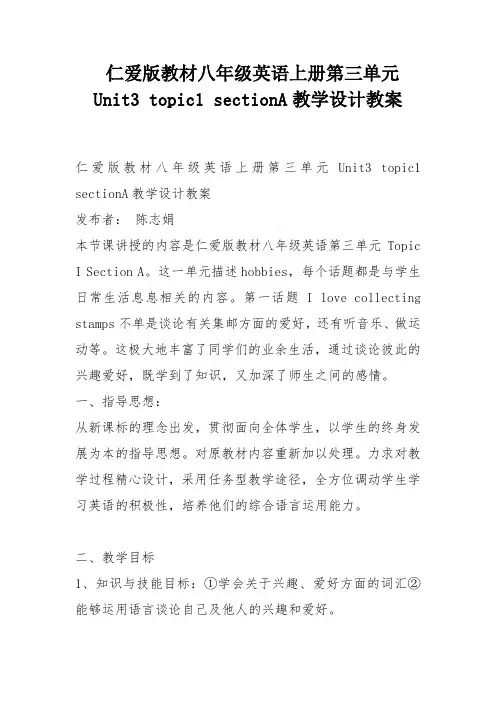
仁爱版教材八年级英语上册第三单元Unit3 topic1 sectionA教学设计教案仁爱版教材八年级英语上册第三单元Unit3 topic1 sectionA教学设计教案发布者:陈志娟本节课讲授的内容是仁爱版教材八年级英语第三单元Topic I Section A。
这一单元描述hobbies,每个话题都是与学生日常生活息息相关的内容。
第一话题I love collecting stamps不单是谈论有关集邮方面的爱好,还有听音乐、做运动等。
这极大地丰富了同学们的业余生活,通过谈论彼此的兴趣爱好,既学到了知识,又加深了师生之间的感情。
一、指导思想:从新课标的理念出发,贯彻面向全体学生,以学生的终身发展为本的指导思想。
对原教材内容重新加以处理。
力求对教学过程精心设计,采用任务型教学途径,全方位调动学生学习英语的积极性,培养他们的综合语言运用能力。
二、教学目标1、知识与技能目标:①学会关于兴趣、爱好方面的词汇②能够运用语言谈论自己及他人的兴趣和爱好。
2、情感目标:有兴趣听英语、说英语、唱歌曲、做游戏,乐于模仿,敢于开口,积极参与,团结协作。
3、学习策略目标:能热情地与他人合作。
共同完成学习任务;主动向老师和同学请教;注意力集中;积极地运用所学英语进行表达和交际。
三、教学重点及难点1、教学重点:学生能够运用各种方式谈论兴趣、爱好、并初步认识感叹句2、教学难点:used to的用法四、教学过程1、课前热身,师生同唱一首歌:进行听、读、说的练习。
a.听前,提出听的任务,让学生听录音后回答问题。
如:What’s Wen Wei’s hobby? Does he often listen to rock music now?b.然后,教师通过以旧带新,对比法呈现新pleased, colect, painting, valuable.并且推出used to 通过上下文学生会很轻松猜其含义,借助例句知其用法used to do sth.从而在一定程度上突破了难点,同时也为Section B的学习作了良好的铺垫。
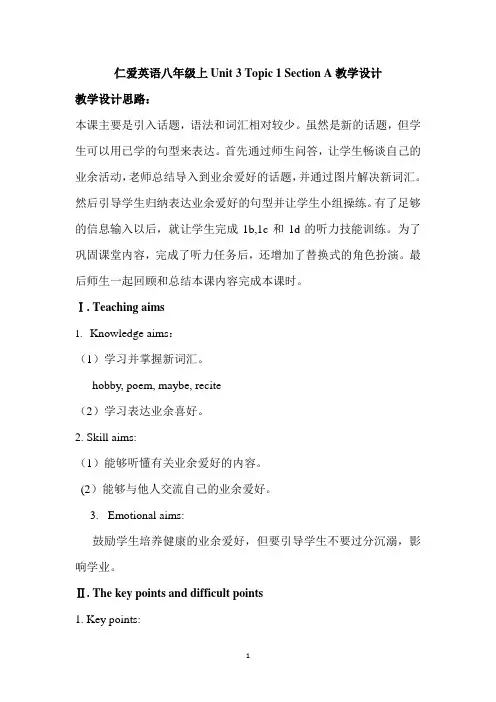
仁爱英语八年级上Unit 3 Topic 1 Section A教学设计教学设计思路:本课主要是引入话题,语法和词汇相对较少。
虽然是新的话题,但学生可以用已学的句型来表达。
首先通过师生问答,让学生畅谈自己的业余活动,老师总结导入到业余爱好的话题,并通过图片解决新词汇。
然后引导学生归纳表达业余爱好的句型并让学生小组操练。
有了足够的信息输入以后,就让学生完成1b,1c和1d的听力技能训练。
为了巩固课堂内容,完成了听力任务后,还增加了替换式的角色扮演。
最后师生一起回顾和总结本课内容完成本课时。
Ⅰ. Teaching aims1.Knowledge aims:(1)学习并掌握新词汇。
hobby, poem, maybe, recite(2)学习表达业余喜好。
2. Skill aims:(1)能够听懂有关业余爱好的内容。
(2)能够与他人交流自己的业余爱好。
3.Emotional aims:鼓励学生培养健康的业余爱好,但要引导学生不要过分沉溺,影响学业。
Ⅱ. The key points and difficult points1. Key points:掌握表达业余爱好的句型,能够正确表达有关业余爱好的活动。
2. Difficult points:Ⅲ. Learning strategies1.通过总结已学的句型来表达新的话题。
2.在听前阶段要有充分的听前准备。
如:扫除词汇障碍。
Ⅳ. Teaching aids:多媒体课件V. Teaching proceduresStep1Greetings设计目的:师生间的问候,吸引学生注意力,使其回归课堂,以便进行本节课学习。
Step2Review1.Let Ss say out the words according to the Chinese meaning and phonetic symbol.2. Let Ss say out the phrases according to the Chinese meaning.3. Introduce my own hobbies briefly.设计目的:该部分起到衔接的作用,通过复习上节课的知识点,为上本节课掌握得不是很好的学生提供再学习的机会,同时也为本节课学习新内容做好铺垫,逐渐培养学生良好的复习习惯。
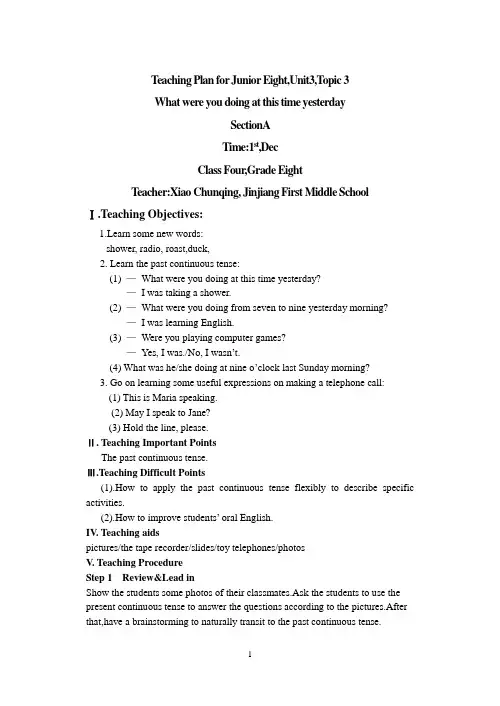
T eaching Plan for Junior Eight,Unit3,T opic 3What were you doing at this time yesterdaySectionATime:1st,DecClass Four,Grade EightT eacher:Xiao Chunqing, Jinjiang First Middle SchoolⅠ.Teaching Objectives:1.Learn some new words:shower, radio, roast,duck,2. Learn the past continuous tense:(1) —What were you doing at this time yesterday?—I was taking a shower.(2) —What were you doing from seven to nine yesterday morning?—I was learning English.(3) —Were you playing computer games?—Yes, I was./No, I wasn’t.(4) What was he/she doing at nine o’clock last Sunday morning?3. Go on learning some useful expressions on making a telephone call:(1) This is Maria speaking.(2) May I speak to Jane?(3) Hold the line, please.Ⅱ. Teaching Important PointsThe past continuous tense.Ⅲ.Teaching Difficult Points(1).How to apply the past continuous tense flexibly to describe specific activities.(2).How to improve students’ oral English.IV. Teaching aidspictures/the tape recorder/slides/toy telephones/photosV. Teaching ProcedureStep 1 Review&Lead inShow the students some photos of their classmates.Ask the students to use the present continuous tense to answer the questions according to the pictures.After that,have a brainstorming to naturally transit to the past continuous tense.Step 2 Presentation1.Listen to the tape and answer the questions.2. Read after the tape,fill in the blanks and underline the important words,phrases and sentences.3. Give the students some minutes to read the dialogue by themselves and ask some students to act out the dialogue in pairs.Step 3 PracticeA guessing game.Ask the students to use their imagination to guess what was he/she doing in the pictures.Step 4 ConsolidationAsk and answer in pairs after the example.Step 5 SummaryLead the students to have a quick looking back on the teaching content in this period.Step 6 HomeworkMake a survey about your group members 'activities at different times last Sunday morning.Talk about it with your group members to find who has spent the most interesting Sunday and then report it to your class.Time What were you doing?7:00—8:00 a.m.8:00—9:00 a.m.9:00—10:00 a.m.10:00—11:00 p.m.Section BThe main activities are 1a, 1c and 2a. 本课重点活动是1a, 1c 和2a. Ⅰ.Teaching aims and demands 教学目标 1. Learn some new words and useful phrases:agree, pleasant, agree with sb., handsome, useful, sad, make faces, laugh 2. Learn some useful sentences: (1)I thought it was just so-so. (2)I thought he was very brave! (3)It ’s nothing serious.(4)Miss Wang was angry with me.3. Go on learning the past continuous tense:(1)—What were you doing at this time last night? —I was watching a Harry Potter movie.(2)Because I made faces and made my classmates laugh when she was giving us a lesson.(3)You weren ’t listening to the teacher.4. Learn to express agreement and disagreement: —I think classical music is pleasant. I agree with you. / Yes, I think so. I don ’t agree. / No, I don ’t think so. I think it ’s boring. Ⅱ. Teaching aids 教具—挂图/课件/录音机/小黑板/卡片Ⅲ. Five-finger Teaching Plan 五指教学方案Step 1 Review 第一步复习(时间:6分钟)通过创设情景,表演对话复习过去进行时,导入新课。

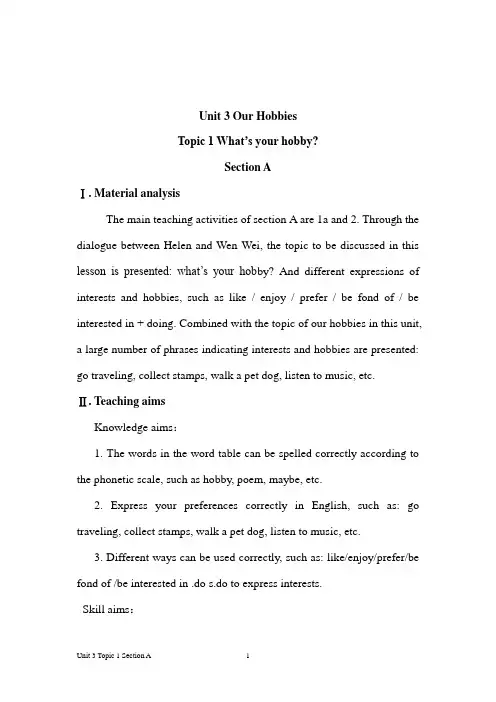
Unit 3 Our HobbiesTopic 1 What’s your hobby?Section AⅠ. Material analysisThe main teaching activities of section A are 1a and 2. Through the dialogue between Helen and Wen Wei, the topic to be discussed in this lesson is presented: what’s your hob by? And different expressions of interests and hobbies, such as like / enjoy / prefer / be fond of / be interested in + doing. Combined with the topic of our hobbies in this unit, a large number of phrases indicating interests and hobbies are presented: go traveling, collect stamps, walk a pet dog, listen to music, etc.Ⅱ. Teaching aimsKnowledge aims:1. The words in the word table can be spelled correctly according to the phonetic scale, such as hobby, poem, maybe, etc.2. Express your preferences correctly in English, such as: go traveling, collect stamps, walk a pet dog, listen to music, etc.3. Different ways can be used correctly, such as: like/enjoy/prefer/be fond of /be interested in .do s.do to express interests.Skill aims:Be able to understand the topics about your preferences and the invitations of friends.Emotional aims:Cultivate students’ interests and hobbies beneficial to learning andhealth.Ⅲ. The key points and difficult pointsKey points:Sentence pattern:1.——What’s your hobby? ——My hobby is...2.I like/enjoy/prefer/be fond of /be interested in +doingDifficult points:be fond of/be interested in+doing sth.Ⅳ. Learning strategiesStudents can express the same meaning with the help of different sentence patterns and sentence structures, which contributes to the flexibility and diversity of oral and written expression.Ⅴ. Teaching aidsComputer multimedia projectorⅥ. Teaching proceduresStep 1 Introduction1. Get students ready for learning.2. Show a short movie about teacher’s li fe on Sunday, such as running, reading, doing exercises. Ask students to guess “What’s my hobby?” or “What do I often do in my spare time?” Teach the new word “hobby”.e.g. Ann likes sports. I think doing sports is Ann’s hobby.3. Write down “What’s your hobby? My hobby is reading.” on the blackboard.4. Ask students “What are Helen and Wen Wei’s hobbies?” (Tell students preview is very important.)Step 2 Presentation1. Write “What are Helen and Wanwei’s hobbies?” on the blackboard. Teacher plays the recording of 1a and lets students find out the answer.2. Finish 1b. Check the answer and teach the new word “recite” by showing pictures.(Show pictures about students reciting English textbook in the morning.)3. Encourage students to look at the pictures in 1c and try to check the phrases according to the pictures.4. Play 1a again and ask students to write down the phrases in 1c.5. Play 1a for the third time, and ask students to write H for Helen’s hobbies, W for Wen Wei’s.6. Provide students 2 minutes to read 1a aloud. Teacher should walkaround the classroom to check whether the students can read and give them some advice or help. Then the whole class read 1a together.7. Finish 1d. Ask students to read 1a and fill in the blanks.Step 3 Consolidation1. Ch eck the answers in 1d and write “Wen Wei enjoys reading stories and listening. Helen loves reciting poems.” on the blackboard. Tell students there are different ways to express the same meaning. Encourage students to find out other sentences which can express the same meaning.2. Finish 2. Ask students to fill in the blanks in 2 according to the pictures. Then play the recording of 2.3. Write down “like/be fond of/be interested in /enjoy /prefer” on the blackboard.4. Ask students to look at 2 carefully and summarize the usage of “like/be fond of/be interested in/ enjoy /prefer”.5. Teacher explains some key points and difficult points to the students: (1) The structure of “like/be fond of / be interested in enjoy/prefer+doing”(2) The key sentences “What’s your hobby?” “My hobby is reading.” Then give students some exercises to check whether they have masteredthem.Step 4 Practice1. Check the answers. Ask students to pay attention to the structures. Guess the meanings of “collect” and “plant” accordi ng to the pictures in 3a.2. Play 3a. Pay attention to the pronunciation.3. Play 3a again.4. Organize the students to play a game. The group leader speaks out a sentence using “love /prefer/be fond of ...” and the activities in 3a. Other group members speak out the sentences with the same meaning. The group which can speak more sentences is the winner in 30 seconds. Step 5 Production1. Guide students to make an interview about students’ hobbies.2. Teacher shows important language points on the computer screen as a summary.Ⅶ.Teaching ReflectionIt’s easy for the students to use the structure of “prefer/be fond of/be interested in/love + doing” after teaching, but it’s hard for them to remember these phrases which are related to the hobbies or outdoor activities. Teachers should think of more ways to practice these phrases.。
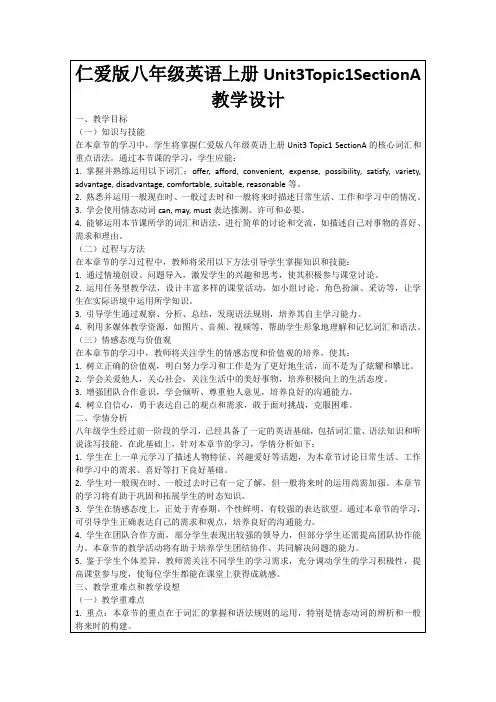
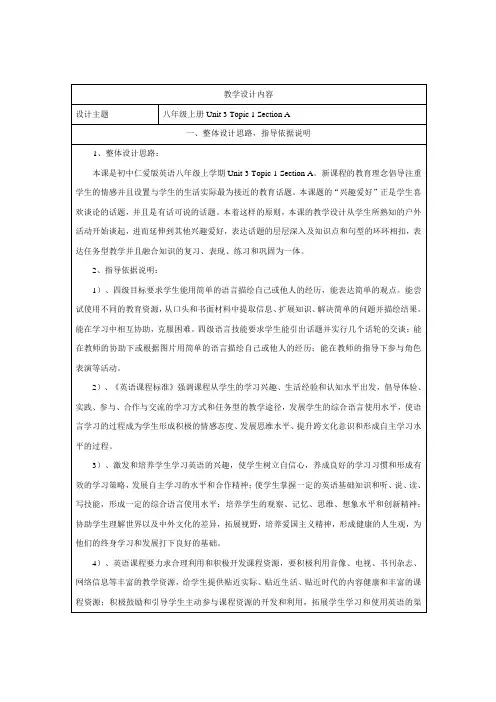
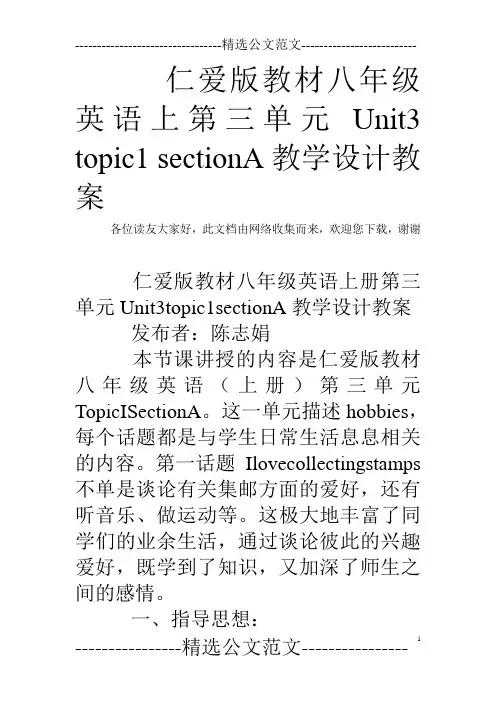
仁爱版教材八年级英语上第三单元Unit3 topic1 sectionA教学设计教案各位读友大家好,此文档由网络收集而来,欢迎您下载,谢谢仁爱版教材八年级英语上册第三单元Unit3topic1sectionA教学设计教案发布者:陈志娟本节课讲授的内容是仁爱版教材八年级英语(上册)第三单元TopicISectionA。
这一单元描述hobbies,每个话题都是与学生日常生活息息相关的内容。
第一话题Ilovecollectingstamps 不单是谈论有关集邮方面的爱好,还有听音乐、做运动等。
这极大地丰富了同学们的业余生活,通过谈论彼此的兴趣爱好,既学到了知识,又加深了师生之间的感情。
一、指导思想:从新课标的理念出发,贯彻面向全体学生,以学生的终身发展为本的指导思想。
对原教材内容重新加以处理。
力求对教学过程精心设计,采用任务型教学途径,全方位调动学生学习英语的积极性,培养他们的综合语言运用能力。
二、教学目标1、知识与技能目标:①学会关于兴趣、爱好方面的词汇②能够运用语言谈论自己及他人的兴趣和爱好。
2、情感目标:有兴趣听英语、说英语、唱歌曲、做游戏,乐于模仿,敢于开口,积极参与,团结协作。
3、学习策略目标:能热情地与他人合作。
共同完成学习任务;主动向老师和同学请教;注意力集中;积极地运用所学英语进行表达和交际。
三、教学重点及难点1、教学重点:学生能够运用各种方式谈论兴趣、爱好、并初步认识感叹句2、教学难点:usedto的用法四、教学过程1、课前热身,师生同唱一首歌:(调动学生的积极性,拉近师生的距离)2、复习love,like,prefer,enjoy+v-ing 结构,为新课作准备①教师简介家人的兴趣爱好mysisterlikesdancing,butshedoesn`tlovesin ging,②师生对话谈论喜欢做的事情,反复应用whatdoyoulove/like/enjoy/preferdoing?巩固用法,增进师生间了解.3、导入:根据对话内容,教师表达SwimmingisA’’教师拿出部分收集的邮票,边让学生看,边表达,collectingstampsismyhobby,导入Topic1标题。
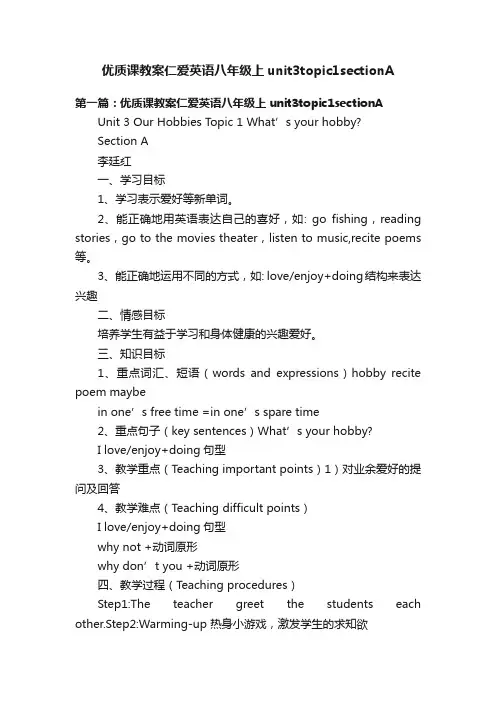
优质课教案仁爱英语八年级上unit3topic1sectionA第一篇:优质课教案仁爱英语八年级上unit3topic1sectionA Unit 3 Our Hobbies Topic 1 What’s your hobby?Section A李廷红一、学习目标1、学习表示爱好等新单词。
2、能正确地用英语表达自己的喜好,如: go fishing,reading stories,go to the movies theater,listen to music,recite poems 等。
3、能正确地运用不同的方式,如: love/enjoy+doing结构来表达兴趣二、情感目标培养学生有益于学习和身体健康的兴趣爱好。
三、知识目标1、重点词汇、短语(words and expressions)hobby recite poem maybein one’s free time =in one’s spare time2、重点句子(key sentences)What’s your hobby?I love/enjoy+doing句型3、教学重点(Teaching important points)1)对业余爱好的提问及回答4、教学难点(Teaching difficult points)I love/enjoy+doing句型why not +动词原形why don’t you +动词原形四、教学过程(T eaching procedures)Step1:The teacher greet the students each other.Step2:Warming-up 热身小游戏,激发学生的求知欲Step3:Lead in.老师背诵一首诗,告诉学生老师的业余爱好是背诗,然后导入新单词和问业余爱好的句型。
Step4:教学巩固新单词教读后学生速记新单词Step5:听课文1a,完成1b.学生听完以后学生展示答案,老师检查答案 Step6:师生合作完成1c(小组讨论,看图猜出他们的爱好,用草稿纸写出有关这些爱好的短语,并了解I love/enjoy+doing这一句型的用法。
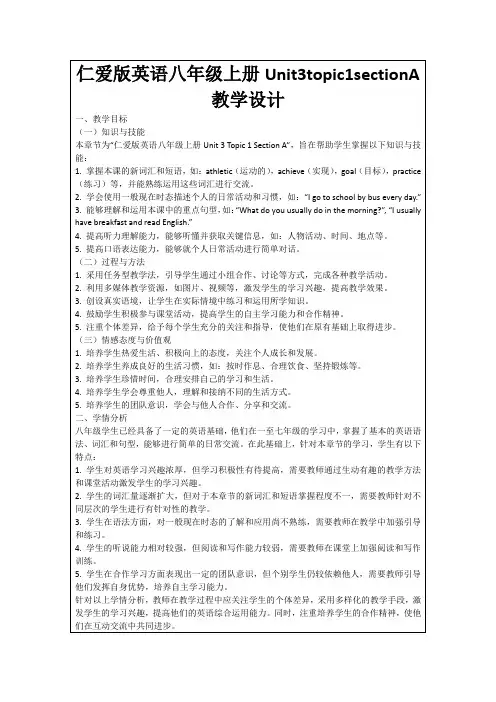

八年级(上)Unit 3 Topic 1 Section A公开课教案一、教材:仁爱版《Project English》八年级(上)Unit 3 Topic 1 Section A二、教具:多媒体设备、录音机、自制单词卡片(自画图片)三、教法:任务型教学法四、教学目标Teaching aims1、认知目标(1) 能根据音标正确拼读并运用单词表中的单词,如: hobby, poem, maybe等。
(2) 能正确地用英语表达自己的喜好,如: go traveling,collect stamps,walk a pet dog, listen to music等。
(3) 能正确地运用不同的方式,如: like/enjoy/prefer/be fond of /be interested in +doing结构来表达兴趣爱好。
(4) 能运用本课所学语言,就自己和他人的喜好用英语进行交流。
2、能力目标通过让学生自主学习,合作学习,角色扮演活动,形成和发展听、说、读、写的综合语言运用的能力。
3、情感目标(1) 通过课前充分的预习准备,运用多媒体辅助教学,并引入竞赛机制,让大部分同学能收获成功,激发他们成就感,满足学生的表现欲,并建立学生学好英语的自信心。
(2) 培养学生良好的兴趣爱好和对生活、未来的一种积极态度。
五.教学重难点The key points and difficult points重点1. What’s your hobby? My hobby is...及like/enjoy/prefer/be fond of /be interested in +doing 句型。
2. be fond of/be interested in等其后动词要用V-ing形式。
难点Talk about hobbies using the expressions learnt in this lesson.六、教学步骤Step1:Warm up(1) Words competitions :Show them some word cards ,revise the new words.(引入竞争机制,调动学习积极性)(2) Lead in: Show the pictures to the students. Saying, “I like traveling. What’s your hobby?”(导入话题)Step2:DiscussTalk about your hobbies by asking and answering.Step3:Listening practiceListen to the sentences. Finish 3a. (培养学生在特定环境领悟和使用语言的能力)Step4: Presentation(师生互动,生生互动)(1) Look, listen and finish 1b.(2) Describe 1a and fill in the blanks in 1d.(3) Read aloud in groups. Then understand the key points.Step5:Role playAct out their dialogues prepared. (俩俩合作,通过不同形式的对话和表演,在虚拟的情境中进行真实的交流,培养学生的语言运用能力。
UNIT 3 Our HobbiesTOPIC 1 What's your hobby?Section A教案教学目标(Objectives):1.确保学生认识和理解一些根本单词的意义和简单口头运用〔To learn the meaning and simple usages of some words and phrases〕。
需要掌握的词组:Saturday study mathAlso art whenWednesday week2.学习使用本单元重点句型及表达〔To use the typical sentences to express〕。
需要掌握的句型:What do you do in your free time?I study Math.3.鼓励学生大胆发言及表达〔To encourage the students to express bravely〕。
4.培养学生对英语学科的兴趣〔To make the students interest in English learning)。
5.增强学生听说读写译的能力〔To strengthen the ability of listening, speaking, reading, writing and translating)。
教学重点〔Key Points):在学习了单词的根底上,以单词为载体,进展主要句型的学习,并了解其中的语法现象,根据具体情境,学会交流对话,侧重句型语法学习,交际意向和课外拓展为重点。
教学方法:游戏,音频,情景教学法,Pair-work两人小组活动,Group-work小组活动,多媒体辅助教学。
教学难点:学生处于初中阶段,对英语有了初步了解,词汇储藏较少,对于学生的要求重点是在会读会说的根底上,能掌握一些根本单词的拼写和造句,了解一定的语法内涵,与人进展简单沟通交流。
教学准备:课件、照片素材、音频文件、教学道具。
仁爱英语八年级上册Unit3Topic1SectionA公开课教案TeachingPlanforJuniorEight,Unit3,Topic3SectionATime:1t,DecClaFour,GradeEightTeacher:某iaoChunqing,JinjiangFirtMiddleSchoolⅠ.TeachingObjective:1.Learnomenewword:hower,radio,roat,duck,2.Learnthepatcontinuoutene:—Iwatakingahower.(2)—Whatwereyoudoingfromeventonineyeterdaymorning—IwalearningEnglih.—Ye,Iwa./No,Iwan’t.(4)Whatwahe/hedoingatnineo’clocklatSundaymorning3.Goonlearningomeuefule某preiononmakingatelephonecall:(1)ThiiMariapeaking.(2)MayIpeaktoJane(3)Holdtheline,pleae.Ⅱ.TeachingImportantPointThepatcontinuoutene.Ⅲ.TeachingDifficultPoint(1).Howtoapplythepatcontinuoutenefle某iblytodecribepecificactivitie.(2).Howtoimprovetudent’oralEnglih.IV.Teachingaidpicture/thetaperecorder/lide/toytelephone/photoV.TeachingProcedureStep1Review&LeadinShowthetudentomephotooftheirclamate.Akthetudenttouethepreentcontinuoutenetoanwerthequetionaccordingtothepicture.Af terthat,haveabraintormingtonaturallytranittothepatcontinuoutene.Step2Preentation1.Litentothetapeandanwerthequetion.2.Readafterthetape,fillintheblankandunderlinetheimportantword,phraeandentence.3.Givethetudentomeminutetoreadthedialoguebythemelveandakometudenttoactoutthedialogueinpair.Step3PracticeAgueinggame.Akthetudenttouetheirimaginationtoguewhatwahe/hedoinginthepicture.Step4ConolidationAkandanwerinpairafterthee某ample.Step5SummaryLeadthetudenttohaveaquicklookingbackontheteachingcontentinth iperiod.Step6HomeworkSundaymorning.Talkaboutitwithyourgroupmembertofindwhohapent themotinteretingSundayandthenreportittoyourcla.SectionBThemainactivitieare1a,1cand2a.本课重点活动是1a,1c和2a.Ⅰ.Teachingaimanddemand教学目标1.Learnomenewwordanduefulphrae:agree,pleaant,agreewithb.,handome,ueful,ad,makeface,laugh2.Learnomeuefulentence:(1)Ithoughtitwajuto-o.(2)Ithoughthewaverybrave!(3)It’nothingeriou.(4)MiWangwaangrywithme.3.Goonlearningthepatcontinuoutene:—IwawatchingaHarryPottermovie.(2)BecaueImadefaceandmademyclamatelaughwhenhewagivingualeon.(3)Youweren’tliteningtotheteacher.4.Learntoe某preagreementanddiagreement:—Ithinkclaicalmuicipleaant.—’tagree./No,Idon’tthinko.Ithinkit’boring.Ⅱ.Teachingaid教具挂图/课件/录音机/小黑板/卡片Ⅲ.Five-fingerTeachingPlan五指教学方案Step1Review第一步复习(时间:6分钟)通过创设情景,表演对话复习过去进行时,导入新课。
Unit3 Topic1 What ’s your hobby ?Section A 授课材料(教材)的电子文档1a Look,listen and sayHelen: What do you often do in your free time ?Wen Wei: I often go fishing.It ’s my favorite hobby. And I also enjoy reading stories and listening to music. It ’s great fun.Well,What ’s your hobby?Helen: I love reciting poems.And I ’m a movie fan,too.I go to the movie theater a lot. I also rent DVDs and watch them at home.Wen Wei: Why not go out and do some outdoor activities?Helen: Sounds good!Maybe I need a change.1d Listen to 1a and fill in the blanks.Helen and Wen Wei are talking about their hobbies. Wen Wei enjoys ____________ ,reading stories and _______ to music. He gets great ______ from these activities, Helen enjoys ___________ poems and__________ movies. She goes to movie _______ a lot and also __________ DVDs and watches them at home.2.look at the picture.Then listen and complete the sentences.3a. Match the pictures with the phrases. Then listen to the sentences and number the pictures.A. walk a pet dogB.listen to musicC. collect stampsD. plant flowersE. climb mountainsF. fly kites G . go traveling H . go swimming1.I love and playing the guitar. 7.I playing soccer. 3.I enjoy to music.6. I am fond of .5. I like poems 4.I like2. I aminterestedin..一、整体设计思路、指导依据说明我校初二的学生正面临着很严重的两极分化的情况,我希望通过对爱好这一话题的讨论,让学生根据自己的实际情况,以听、说训练为主线,从同学们的讨论、发言、听力,表演和采访中找到答案,以饱满的精神面貌、充沛的精力投入到初二的学习和生活中去。
Unit 3 Our Hobbies
Topic 1 What’s your hobby
Section A
李廷红
一、学习目标
1、学习表示爱好等新单词。
2、能正确地用英语表达自己的喜好,如: go fishing,reading stories,go to the movies theater,
listen to music,recite poems等。
3、能正确地运用不同的方式,如: love/enjoy+doing结构来表达兴趣
二、情感目标
培养学生有益于学习和身体健康的兴趣爱好。
三、知识目标
1、重点词汇、短语(words and expressions)
hobby recite poem maybe
in one’s free time =in one’s spare time
2、重点句子(key sentences)
What’s your hobby
I love/enjoy+doing句型
3、教学重点(Teaching important points)
1)对业余爱好的提问及回答
4、教学难点(Teaching difficult points)
I love/enjoy+doing句型
why not +动词原形why don’t you +动词原形
四、教学过程(Teaching procedures)
Step1:The teacher greet the students each other.
Step2:Warming-up
热身小游戏,激发学生的求知欲
Step3:Lead in .
老师背诵一首诗,告诉学生老师的业余爱好是背诗,然后导入新单词和问业余爱好的句型。
Step4:教学巩固新单词
教读后学生速记新单词
Step5:听课文1a,完成1b.
学生听完以后学生展示答案,老师检查答案
Step6:师生合作完成1c
(小组讨论,看图猜出他们的爱好,用草稿纸写出有关这些爱好的短语,并了解I love/enjoy+doing这一句型的用法。
)
教师播放录音,学生听录音写出答案并展示答案
教师检查答案
Step7:巩固
带学生学习1a,师生共同找出关键词并板书在黑板上。
in one’s free time =in one’s spare time
why not +动词原形why don’t you +动词原形
I enjoy/love/+V-ing
Step8:角色扮演朗读1a
Step9:完成练习
小组讨论得出答案
学生展示答案,教师检查答案(小组活动)
Step10:总结
Homework
1.完成本部分的课堂练习册。
2.记忆本堂课所学句子和短语
3.背诵1a.
五、板书设计(Board-writing design)
Unit 3 Our Hobbies
Topic 1 What’s your hobby
Section A
单词/ 短语句子
hobby recite poem maybe What’s your hobby
in one’s free time =in one’s spare time I love/enjoy +V-ing。